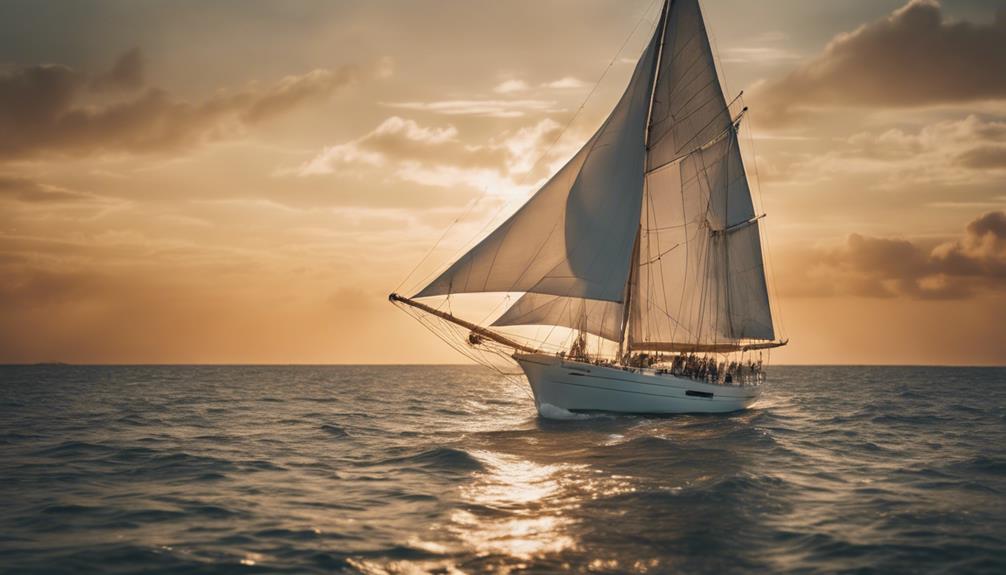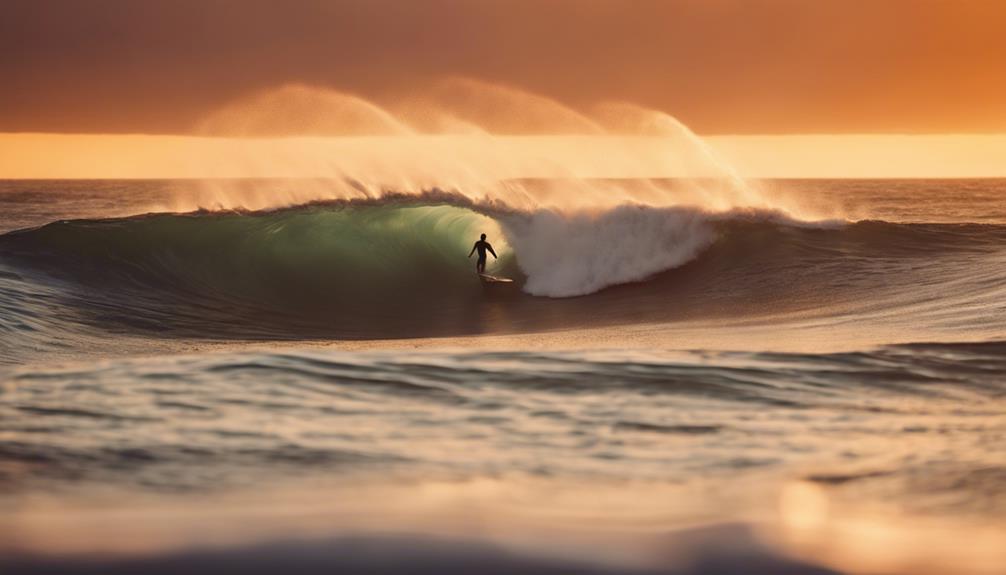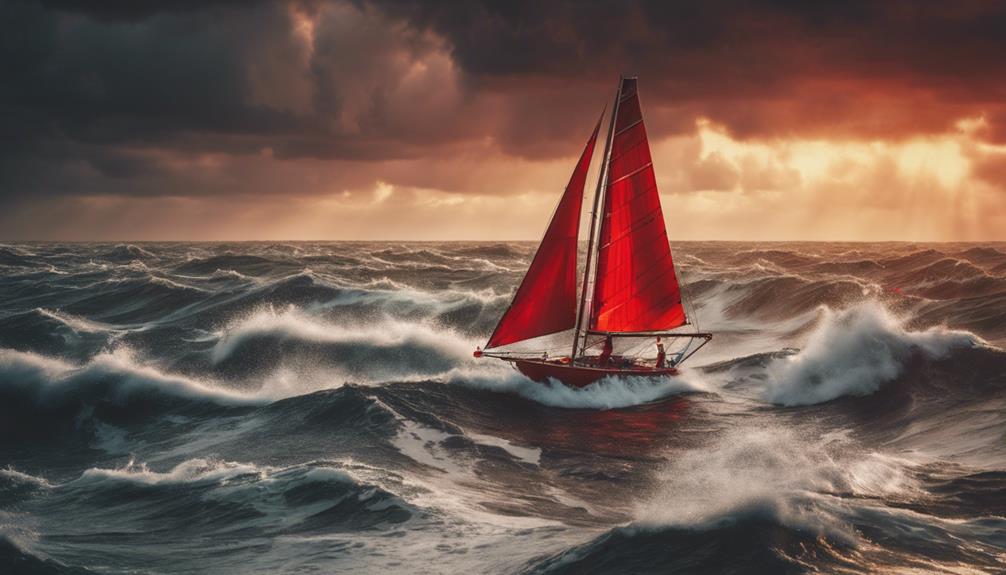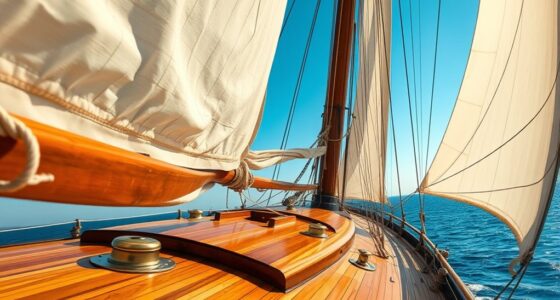The largest sailboats ever built include the France II and Thomas W. Lawson. France II, launched in 1912, reaches an impressive 146.5 meters (480 feet) and holds the title for the largest sailing vessel. Meanwhile, Thomas W. Lawson, a seven-masted design, measures 145 meters (475 feet). These vessels represent the pinnacle of sailing ship engineering before the era of steam power. Today, modern yachts like Sailing Yacht A also highlight advancements in design and luxury. If you're curious about how these iconic boats shaped maritime history, you might want to explore further.
Key Takeaways
- France II is the largest sailing vessel ever built, measuring 146.5 meters (480 feet) and launched in 1912.
- The Thomas W. Lawson, a seven-masted ship, is the largest pure sailing ship at 145 meters (475 feet).
- Modern large yachts include Sailing Yacht A at 142.8 meters and Koru at 127 meters, showcasing advanced design.
- The transition from sail to steam power diminished the practicality of large sailing vessels in the early 20th century.
Overview of Record-Holding Vessels
When it comes to record-holding vessels, the largest sailing ships showcase remarkable engineering and historical significance, with notable examples like the France II and Thomas W. Lawson leading the way.
The France II, launched in 1912, remains the largest sailing vessel ever built, measuring an impressive 146.5 meters (480 feet) before its grounding in 1922. The Thomas W. Lawson, the largest pure sailing ship, followed closely at 145 meters (475 feet), tragically lost at sea in 1907.
These vessels represent the peak of sailing design during a critical shift from sail to steam power in the early 20th century.
Today, the landscape of record-holding vessels has evolved to include modern sailing yachts, with Sailing Yacht A emerging as a notable contender at 142.8 meters (465 feet). Alongside Koru, measuring 127 meters (417 feet), these modern yachts push the boundaries of innovation and design.
As you explore the world of record-holding vessels, you'll find a blend of historical significance and cutting-edge technology, illustrating the evolution of sailing from its grand past to a new era of maritime achievement.
Largest Sailing Vessel

When you think about the largest sailing vessel, the France II stands out with its impressive length of 146.5 meters. Launched in 1912, it not only represents a remarkable achievement in shipbuilding but also marks a significant point in maritime history as sailing shifted to steam power.
Let's explore its fascinating overview, historical significance, and the impact of this change.
France II Overview
France II stands out as the largest sailing vessel ever constructed, measuring an impressive 146.5 meters (480 feet) in length. Launched on November 9, 1912, at Chantiers et Ateliers de la Gironde in Bordeaux, France, this remarkable sailing ship had a gross tonnage of 5,633, showcasing its significant size and capacity.
As the largest sailing vessel of its time, France II represented the pinnacle of maritime engineering in the early 20th century. Its sleek design and powerful sails made it a marvel on the water, capturing the imagination of those who witnessed its grandeur.
However, its operational history was short-lived, as it tragically ran aground on July 12, 1922, off the coast of New Caledonia. Despite its brief tenure, France II's legacy as the largest sailing ship remains unmatched.
The vessel's construction and subsequent demise illustrate the shift from traditional sailing vessels to steam-powered ships, marking a pivotal moment in maritime history. If you're fascinated by sailing ships and their evolution, learning about France II will deepen your appreciation for these magnificent vessels.
Historical Significance
The remarkable history of France II illustrates its profound impact on maritime technology and design during a pivotal era. As the largest sailing vessel ever recorded, it measured an impressive 146.5 meters (480 feet) in length and epitomized the peak of ship design before the shift to steam power.
Launched in 1912, France II wasn't just a sailing ship; it was a symbol of innovation that reflected the aspirations of yachting enthusiasts and maritime engineers alike. Its construction in Bordeaux by Chantiers et Ateliers de la Gironde showcased advancements in materials and techniques, pushing the boundaries of what was possible for sailing vessels at the time.
The historical significance of France II lies not only in its size but also in its role within a broader trend of ship design that prioritized performance and elegance. Although it held the title of the largest sailing ship for a brief period, its grounding in 1922 marked the end of an era.
France II stands as a reflection of the ingenuity of its builders and the evolution of maritime technology just before the dominance of steamships changed the landscape forever.
Transition to Steam Power
As sailing vessels like France II dominated the seas, the emergence of steam power began to challenge their supremacy, offering greater maneuverability and cargo capacity. The early 20th century marked a considerable technological change, as steamships quickly proved they could navigate with precision and speed that sailing vessels couldn't match. France II, the largest sailing vessel ever built, exemplified the pinnacle of sailing design, yet even it couldn't escape the tide of innovation.
The shift to steam power wasn't just about speed; it was essential for larger cargo loads, allowing ships to transport goods more efficiently. This change markedly impacted maritime trade and travel, gradually rendering massive sailing ships less practical. While France II showcased the artistry and engineering of its time, the advancements in steam technology highlighted the limitations of even the most impressive sailing vessels.
Ultimately, as you look back at the era of France II, you can appreciate the beauty of its design while recognizing how steam power reshaped the industry. This change marked the end of an age for traditional sailing ships, ushering in a new era of maritime exploration and commerce.
Largest Pure Sailing Ship

Among the largest pure sailing ships ever built, the Thomas W. Lawson stands out with its impressive length of 145 meters (475 feet). Commissioned in 1901 by a mining magnate, this vessel was designed to showcase the potential of sailing ships during the steam era. Featuring an innovative seven-masted design, it aimed to push the boundaries of sailing technology. However, despite its groundbreaking construction, the Lawson proved impractical for navigation and cargo capacity.
With a gross tonnage of 5,218, the Thomas W. Lawson represented the pinnacle of sailing vessel design before steam power took over. Unfortunately, its story ended tragically when it was lost in a storm on December 14, 1907, off the Isles of Scilly. This incident highlighted the challenges and vulnerabilities associated with such large sailing vessels.
As you explore the history of maritime innovation, the Thomas W. Lawson serves as a reminder of the ambitions and limitations of its time. It stands not only as the largest pure sailing ship ever built but also as a symbol of an era that struggled to adapt to changing technologies.
Notable Sailing Yachts

Notable sailing yachts showcase the pinnacle of luxury and engineering, pushing the boundaries of design and performance on the water.
Among these is the largest sailing yacht, Sailing Yacht A, which measures an impressive 142.8 meters (465 feet) and features innovative carbon fiber masts towering 100 meters high. Right behind it is Oceanco's Koru, a stunning 127-meter (417-foot) vessel designed for comfort and performance.
You might also be intrigued by the Black Pearl, measuring 106.7 meters (350 feet). This yacht is groundbreaking, leveraging solar power and a unique Dynarig that allows it to deploy over 31,000 square feet of sail in under seven minutes.
If classic design captivates you, seek no further than Athena, a classic sailing yacht built in 2004 that spans 90 meters (295 feet) and boasts a charming three-masted gaff-rigged design.
Lastly, there's the Maltese Falcon, an 88-meter (288-foot) three-masted schooner, famous for its automated DynaRig square rigging, enabling it to reach speeds of up to 25 knots.
Each of these yachts represents the height of maritime excellence.
Historical Context of Sailing Vessels

You might find it fascinating how the changeover to steam power reshaped the world of sailing vessels.
Innovations in design, like the seven-masted Thomas W. Lawson, pushed boundaries but also highlighted practical challenges.
This shift reflects a pivotal moment in maritime history, blending traditional craftsmanship with emerging technologies.
Transition to Steam Power
The early 20th century marked a pivotal shift in maritime history as sailing vessels faced increasing competition from the burgeoning steam power technology. This change had profound implications for maritime transportation and commerce.
The largest sailing vessels, like France II and Thomas W. Lawson, began to struggle against the efficiency and reliability of steamships. France II, launched in 1912, briefly held the title of the largest sailing ship but ran aground in 1922, highlighting the vulnerabilities of sailing during this era.
The seven-masted Thomas W. Lawson, commissioned in 1901, aimed to demonstrate that sailing could still thrive alongside steam power. However, its impractical design ultimately led to its loss in 1907. As steamships gained prominence, you could see a marked decline in the dominance of sailing vessels, both in maneuverability and cargo capacity.
The influence of yachting enthusiasts also shaped the design and construction of sailing vessels during this change, working to maintain relevance in a rapidly changing maritime landscape.
Ultimately, the shift to steam power not only redefined the industry but also showcased the resilience and adaptability of sailing traditions.
Innovation in Vessel Design
As steam power began to dominate maritime transportation, innovations in vessel design emerged to enhance the performance and efficiency of sailing ships, reflecting a dynamic response to changing technological landscapes.
During this period, the largest sailing yachts were crafted with advanced designs, pushing the boundaries of what was possible in maritime technology.
Key innovations included:
- Multi-masted configurations: Vessels like the Thomas W. Lawson showcased seven masts to harness wind power effectively.
- Increased length and size: France II, at 146.5 meters, redefined the dimensions of sailing ships, emphasizing stature in the maritime world.
- Enhanced materials: The use of stronger hull materials improved durability and maneuverability, a necessity in an era where steamships were rising to prominence.
These advancements highlight how yachting enthusiasts influenced design and construction, setting a precedent for contemporary sailing yachts.
The legacy of these record-holding vessels continues to inspire modern innovations, ensuring that both tradition and technology thrive in the world of sailing.
Innovative Design Features
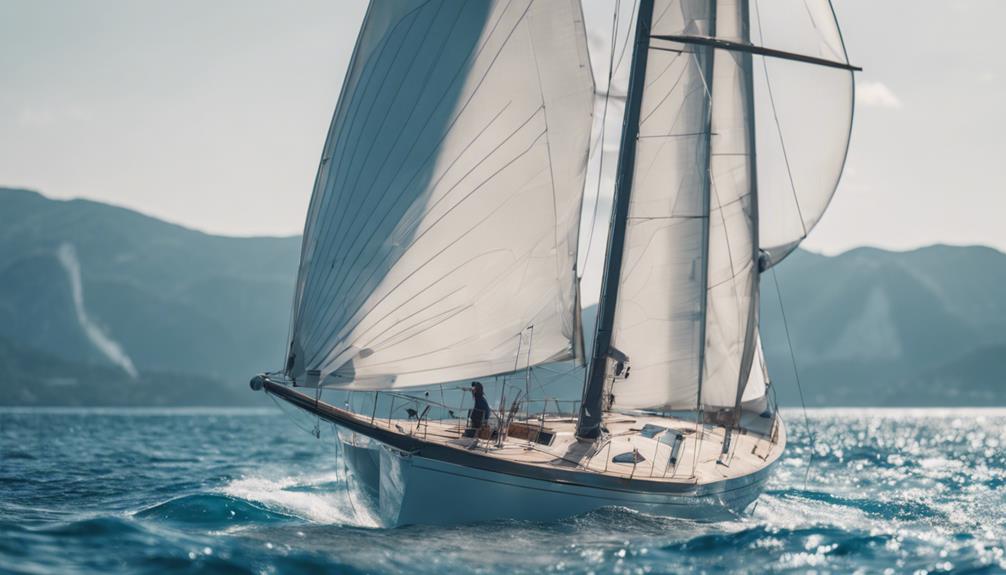
Innovative design features in the world's largest sailboats, like Sailing Yacht A's cutting-edge carbon fiber masts and Black Pearl's energy-efficient Dynarig, redefine modern sailing capabilities. These advancements showcase the use of innovative materials that enhance both performance and sustainability.
For instance, Sailing Yacht A boasts three impressive 100-meter-high unstayed carbon fiber masts, demonstrating how lightweight materials can greatly impact speed and agility.
The Black Pearl takes innovation further with its variable pitch propellers and solar power generation, maximizing energy efficiency. Similarly, Maltese Falcon's automated DynaRig system allows for rapid sail deployment, using its three rotating carbon fiber masts to harness over 25,000 square feet of sail area effectively.
Koru, the tallest sailing yacht at 127 meters, blends classic design lines with modern amenities, embodying a perfect balance of tradition and technology.
Meanwhile, Aquijo stands out as the largest high-performance ketch, featuring two 90-meter masts and exceptional sailing capabilities.
These innovative design features not only elevate the status of the largest sailing yachts but also pave the way for a new era in yacht construction and performance.
Luxury Amenities in Yachts

Luxury amenities in the world's largest sailing yachts create an unparalleled experience, combining opulence and comfort for those on board. These yachts are designed not just for sailing but for indulging in a lavish lifestyle at sea. You'll find features that elevate your journey, making every moment unforgettable.
Here are some standout amenities you can expect:
- Spacious outdoor lounges for relaxation and socializing while enjoying breathtaking views.
- Large pools on decks, providing a revitalizing escape under the sun.
- Luxurious cabins with rich finishes and en-suite bathrooms, ensuring comfort and privacy.
Vessels like the largest sailing yacht, Sailing Yacht A, and the elegant Athena, with its classic lines, showcase how luxury amenities blend seamlessly with advanced design features.
Whether it's a submarine garage or solar power capabilities on the Black Pearl, these yachts redefine what it means to sail in style. Each detail, from entertainment options to exquisite dining spaces, invites you to experience the epitome of luxury while traversing the open waters.
Transition From Sailing to Power
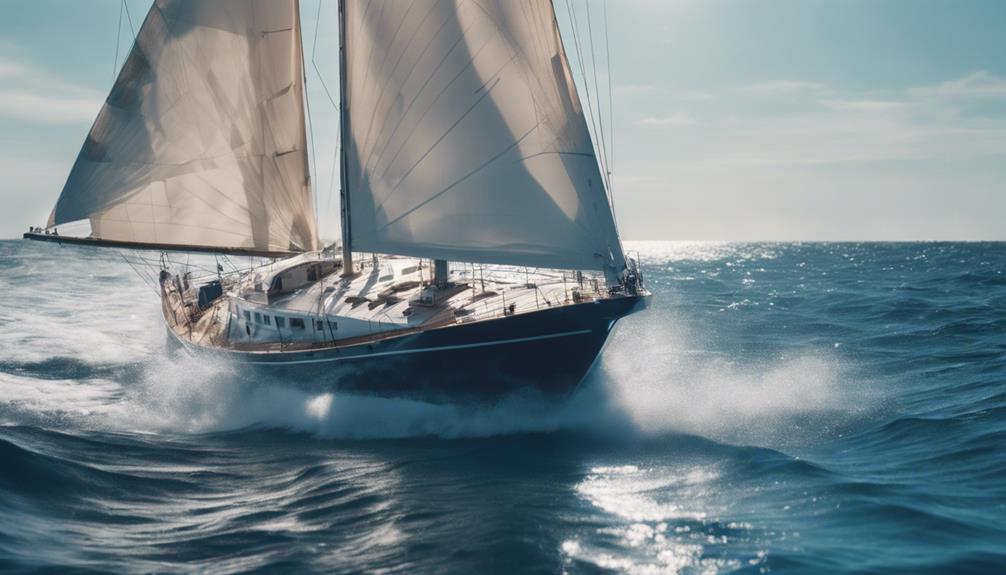
As you explore the shift from sailing to power, you'll notice how technological advancements drove this change.
Economic factors also played a vital role, making steam-powered vessels more appealing for trade and travel.
Understanding these dynamics helps clarify why sailing ships gradually lost their prominence in maritime history.
Technological Advancements in Sailing
The shift from traditional sailing vessels to steam power revolutionized maritime technology, challenging sailors and designers to adapt and enhance their craft for better performance and efficiency.
As the competition from steamships grew, the need for innovation in sailing designs became apparent. You'd see this in the development of larger yachts, featuring cutting-edge materials and designs that combined modern technology with a classic exterior.
Consider the following technological advancements that emerged during this period:
- Aluminium superstructure: Lighter and stronger than wood or steel, it allowed for enhanced performance.
- Sophisticated rigging: Improved sail configurations greatly increased maneuverability and speed.
- Durable hulls: The introduction of iron and steel hulls provided greater longevity and efficiency.
These advancements not only made sailing vessels more competitive but also paved the way for the largest yachts to thrive in an evolving maritime landscape.
This shift reflected a blend of tradition and modernity, showcasing the resilience and adaptability of sailing craft in the face of technological change.
Economic Factors Influencing Transition
Rising maintenance costs for large sailing ships pushed many shipping companies to embrace the efficiency of steam power. Economic factors played a vital role in this change. As the early 20th century unfolded, the financial burden of maintaining sailing vessels became increasingly unsustainable. Steam-powered ships emerged as a more affordable alternative, offering greater reliability and reduced operational costs.
With steam engines, shipping companies could transport larger cargo volumes at faster speeds, which was essential for thriving in competitive commercial shipping markets. The ability to operate on consistent schedules further heightened the appeal of steamships, meeting the demands of industries that required timely deliveries.
Additionally, the shift reflected changing trade patterns and the influence of globalization. As markets expanded and evolved, the need for efficient maritime transportation became paramount. By the 1920s, steam power dominated maritime transport, fundamentally altering the economic landscape and greatly reducing the number of large sailing vessels in operation.
This change not only marked the end of an era for sailing vessels but also paved the way for a new age in shipping that prioritized efficiency and economic viability.
Record-Keeping in Maritime History
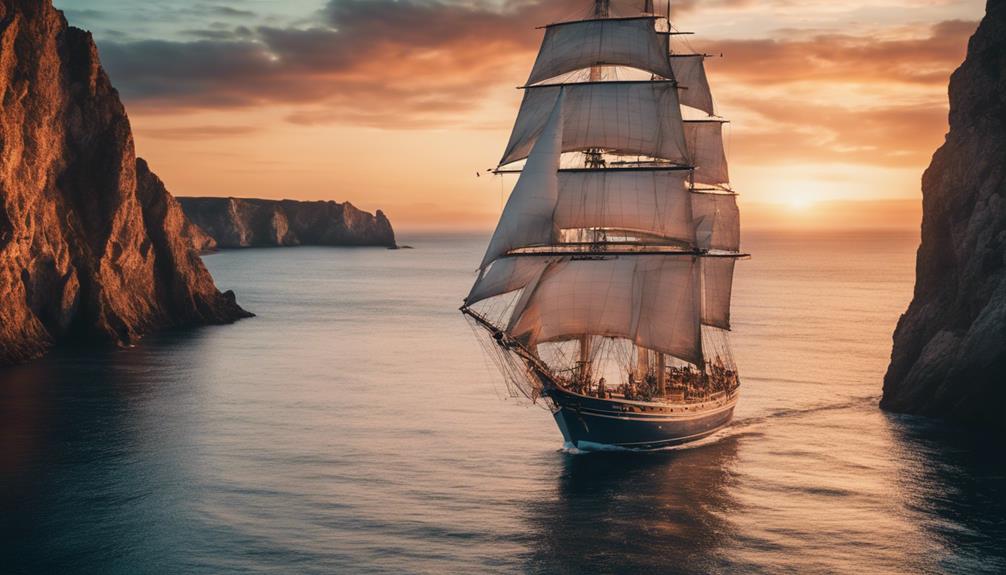
Record-keeping in maritime history constantly evolves, reflecting the launch of new vessels and the validation of existing records. This evolution is essential for understanding the development of the largest sailing ship and the innovations in vessel design. Accurate documentation keeps the maritime heritage alive and helps you appreciate the journey from traditional sailing ships to modern vessels.
Consider these key aspects of record-keeping in maritime history:
- Frequent Updates: New vessels are regularly launched, prompting updates to record titles.
- Access Requirements: Thorough lists often require registration to guarantee accuracy.
- Historical Context: Understanding past record holders, like France II, enhances your appreciation of maritime achievements.
Legacy of Iconic Sailing Ships
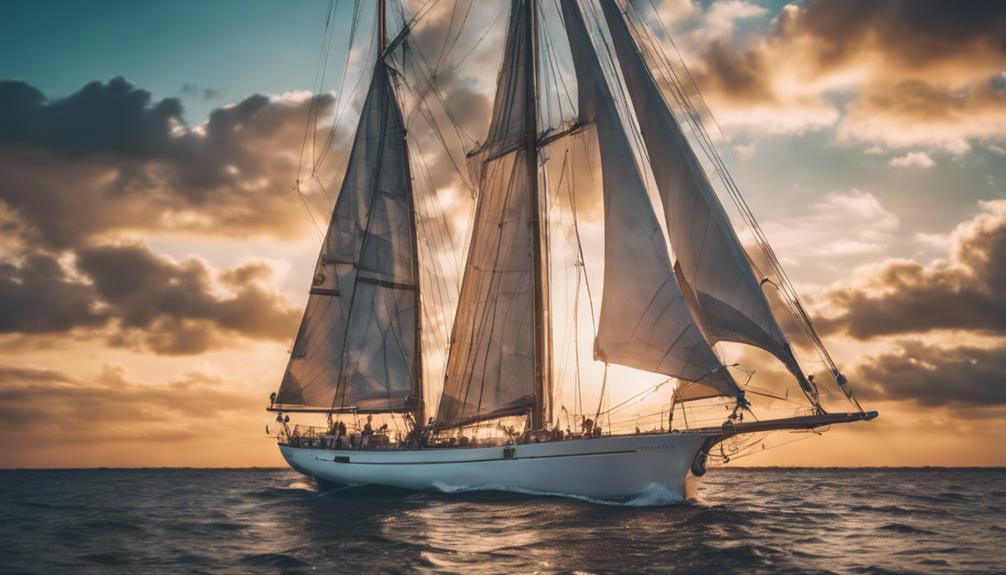
Iconic sailing ships like France II and Thomas W. Lawson not only set records in their time but also left a lasting impact on the design and culture of modern sailing vessels. These remarkable sailing vessels represented the pinnacle of maritime engineering, showcasing innovative designs that pushed the boundaries of what was possible in their era.
Their legacy is evident today, as many modern yachts draw inspiration from the sleek lines and grand profiles of these historic sailing ships. While they faced challenges such as maneuverability and cargo capacity, their influence on sailing vessel design remains undeniable. You can see echoes of their grandeur in contemporary racing yachts and luxury sailboats alike.
As you explore the world of sailing, it's crucial to recognize how these iconic ships helped shape the maritime culture you enjoy today. Their achievements not only celebrated the art of sailing but also inspired a renewed fascination with large sailing vessels.
Frequently Asked Questions
What Is the Largest Sailing Vessel Ever?
You might find that the largest sailing vessel ever recorded is the France II, measuring 146.5 meters and launched in 1912. Its reign was short-lived due to grounding in 1922 off New Caledonia.
Who Owns the Largest Sailboat on Earth?
The largest sailboat on earth belongs to Andrey Melnichenko, measuring an impressive 142.8 meters long. His ownership highlights a passion for innovative yacht design, blending luxury with advanced sailing capabilities that redefine maritime standards.
What Is the Biggest Sailboat One Person Can Sail?
You can typically sail a solo-friendly sailboat up to 30 to 40 feet in length. With advancements like roller furling and electric winches, some sailors manage larger vessels, even up to 50 feet.
What Is the Largest Single Mast Sailboat in the World?
You might think size matters, but the largest single-mast sailboat is the Maltese Falcon, measuring 88 meters. Its innovative design and automated rigging allow for impressive performance, making it a marvel of modern sailing technology.
What Sets the Record-Holding Largest Sailboat Apart from Other Majestic Vessels on the Water?
The biggest sailboat in the world is truly a marvel on the water. Its sheer size and grandeur set it apart from other majestic vessels. With its impressive sails and towering masts, it commands attention and leaves onlookers in awe of its incredible scale and beauty.
Conclusion
In the world of sailing, it's fascinating to note that the largest sailing vessel, the *Athenian*, boasts a staggering length of 469 feet!
This incredible record highlights not just engineering prowess but also the enduring allure of sailing.
As you explore the legacy of these magnificent ships, remember that they represent centuries of maritime history and adventure.
Whether for luxury or competition, sailing vessels will continue to capture our imaginations for generations to come.

